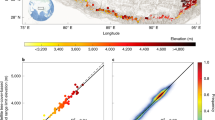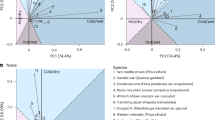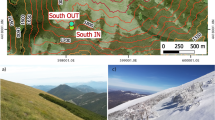Abstract
Understanding how climate change influences succession is fundamental for predicting future forest composition. Warming is expected to accelerate species succession at their cold thermal ranges, such as alpine treelines. Here we examined how interactions and successional strategies of the early-successional birch (Betula utilis) and the late-successional fir (Abies spectabilis) affected treeline dynamics by combining plot data with an individual-based treeline model at treelines in the central Himalayas. Fir showed increasing recruitment and a higher upslope shift rate (0.11 ± 0.02 m yr−1) compared with birch (0.06 ± 0.03 m yr−1) over the past 200 years. Spatial analyses indicate strong interspecies competition when trees were young. Model outputs from various climatic scenarios indicate that fir will probably accelerate its upslope movement with warming, while birch recruitment will decline drastically, forming stable or even retreating treelines. Our findings point to accelerating successional dynamics with late-successional species rapidly outcompeting pioneer species, offering insight into future forest succession and its influences on ecosystem services.
This is a preview of subscription content, access via your institution
Access options
Access Nature and 54 other Nature Portfolio journals
Get Nature+, our best-value online-access subscription
27,99 € / 30 days
cancel any time
Subscribe to this journal
Receive 12 digital issues and online access to articles
118,99 € per year
only 9,92 € per issue
Buy this article
- Purchase on SpringerLink
- Instant access to full article PDF
Prices may be subject to local taxes which are calculated during checkout




Similar content being viewed by others
Data availability
The CRU TS v.4.07 climate dataset was obtained from https://crudata.uea.ac.uk/cru/data/hrg/. The SSP scenarios in the Coupled Model Intercomparison Project Phase 6 were downloaded from https://data.isimip.org/. Occurrence data for Himalayan birch and Himalayan fir were retrieved using the Global Biodiversity Information Facility database (https://www.gbif.org/). The data have been archived in the National Tibetan Plateau Data Center at https://doi.org/10.11888/Terre.tpdc.301173. Source data are provided with this paper.
Code availability
Statistical analysis in this study was performed with publicly available packages in R (version 4.3.1)75 and Programita software (version ProgramitaNovember2018.exe) (https://programita.org/)64. The custom code for the analysis of the data and the modified Sygera Treeline Model has been archived in the National Tibetan Plateau Data Center at https://doi.org/10.11888/Terre.tpdc.301173.
References
Levin, S. A. The problem of pattern and scale in ecology: the Robert H. MacArthur award lecture. Ecology 73, 1943–1967 (1992).
Prach, K. & Walker, L. R. Four opportunities for studies of ecological succession. Trends Ecol. Evol. 26, 119–123 (2011).
Collins, C. G. et al. Global change re-structures alpine plant communities through interacting abiotic and biotic effects. Ecol. Lett. 25, 1813–1826 (2022).
Kraft, N. J. et al. Community assembly, coexistence and the environmental filtering metaphor. Funct. Ecol. 29, 592–599 (2015).
Callaway, R. M. et al. Positive interactions among alpine plants increase with stress. Nature 417, 844–848 (2002).
Sanczuk, P. et al. Competition mediates understorey species range shifts under climate change. J. Ecol. 110, 1813–1825 (2022).
Koffel, T., Daufresne, T. & Klausmeier, C. A. From competition to facilitation and mutualism: a general theory of the niche. Ecol. Monogr. 91, e01458 (2021).
McIntire, E. J. & Fajardo, A. Beyond description: the active and effective way to infer processes from spatial patterns. Ecology 90, 46–56 (2009).
Dial, R. J., Maher, C. T., Hewitt, R. E. & Sullivan, P. F. Sufficient conditions for rapid range expansion of a boreal conifer. Nature 608, 546–551 (2022).
Camarero, J. J. et al. Global fading of the temperature–growth coupling at alpine and polar treelines. Glob. Change Biol. 27, 1879–1889 (2021).
Körner, C. Alpine Treelines: Functional Ecology of the Global High Elevation Tree Limits (Springer Science & Business Media, 2012).
Sigdel, S. R. et al. Moisture-mediated responsiveness of treeline shifts to global warming in the Himalayas. Glob. Change Biol. 24, 5549–5559 (2018).
Liang, E. et al. Species interactions slow warming-induced upward shifts of treelines on the Tibetan Plateau. Proc. Natl Acad. Sci. USA 113, 4380–4385 (2016).
Camarero, J. J. & Gutiérrez, E. Pace and pattern of recent treeline dynamics: response of ecotones to climatic variability in the Spanish Pyrenees. Climatic Change 63, 181–200 (2004).
Elliott, G. P. Influences of 20th-century warming at the upper tree line contingent on local-scale interactions: evidence from a latitudinal gradient in the Rocky Mountains, USA. Glob. Ecol. Biogeogr. 20, 46–57 (2011).
Penuelas, J. & Boada, M. A global change-induced biome shift in the Montseny mountains (NE Spain). Glob. Change Biol. 9, 131–140 (2003).
Harsch, M. A., Hulme, P. E., McGlone, M. S. & Duncan, R. P. Are treelines advancing? A global meta‐analysis of treeline response to climate warming. Ecol. Lett. 12, 1040–1049 (2009).
Lu, X., Liang, E., Wang, Y., Babst, F. & Camarero, J. J. Mountain treelines climb slowly despite rapid climate warming. Glob. Ecol. Biogeogr. 30, 305–315 (2021).
Sharma, S. et al. North American tree migration paced by climate in the West, lagging in the East. Proc. Natl Acad. Sci. USA 119, e2116691118 (2022).
Ali, M. et al. Contrasting treeline dynamics of pine and birch in response to climate warming in the Karakoram. Trees 36, 1923–1932 (2022).
Sigdel, S. R., Liang, E., Wang, Y., Dawadi, B. & Camarero, J. J. Tree-to-tree interactions slow down Himalayan treeline shifts as inferred from tree spatial patterns. J. Biogeogr. 47, 1816–1826 (2020).
Bader, M. Y. et al. A global framework for linking alpine-treeline ecotone patterns to underlying processes. Ecography 44, 265–292 (2021).
Gallou, A. et al. Diurnal temperature range as a key predictor of plants’ elevation ranges globally. Nat. Commun. 14, 7890 (2023).
Tylianakis, J. M., Didham, R. K., Bascompte, J. & Wardle, D. A. Global change and species interactions in terrestrial ecosystems. Ecol. Lett. 11, 1351–1363 (2008).
He, Q., Bertness, M. D. & Altieri, A. H. Global shifts towards positive species interactions with increasing environmental stress. Ecol. Lett. 16, 695–706 (2013).
Kunstler, G. et al. Plant functional traits have globally consistent effects on competition. Nature 529, 204–207 (2016).
Rumpf, S. B. et al. Extinction debts and colonization credits of non-forest plants in the European Alps. Nat. Commun. 10, 4293 (2019).
Mekonnen, Z. A., Riley, W. J., Randerson, J. T., Grant, R. F. & Rogers, B. M. Expansion of high-latitude deciduous forests driven by interactions between climate warming and fire. Nat. Plants 5, 952–958 (2019).
Dulamsuren, C. et al. Hydraulic architecture and vulnerability to drought-induced embolism in southern boreal tree species of Inner Asia. Tree Physiol. 39, 463–473 (2019).
Yang, Q. et al. Temporal dynamics of range expander and congeneric native plant responses during and after extreme drought events. Ecol. Monogr. 92, e1529 (2022).
Lyu, S. & Alexander, J. M. Competition contributes to both warm and cool range edges. Nat. Commun. 13, 2502 (2022).
Wang, X. et al. Enhanced habitat loss of the Himalayan endemic flora driven by warming-forced upslope tree expansion. Nat. Ecol. Evol. 6, 890–899 (2022).
Cantera, I. et al. The importance of species addition ‘versus’ replacement varies over succession in plant communities after glacier retreat. Nat. Plants 10, 256–267 (2024).
Meng, Y., Li, S.-P., Wang, S., Meiners, S. J. & Jiang, L. Scale-dependent changes in ecosystem temporal stability over six decades of succession. Sci. Adv. 9, eadi1279 (2023).
Johnson, E. A. & Miyanishi, K. Testing the assumptions of chronosequences in succession. Ecol. Lett. 11, 419–431 (2008).
IPCC Climate Change 2022: Impacts, Adaptation, and Vulnerability (eds Pörtner, H.-O.) (Cambridge Univ. Press, 2022).
Liang, E., Dawadi, B., Pederson, N. & Eckstein, D. Is the growth of birch at the upper timberline in the Himalayas limited by moisture or by temperature? Ecology 95, 2453–2465 (2014).
Pandey, S., Cherubini, P., Saurer, M., Carrer, M. & Petit, G. Effects of climate change on treeline trees in Sagarmatha (Mt. Everest, Central Himalaya). J. Veg. Sci. 31, 1144–1153 (2020).
Gaire, N. P., Koirala, M., Bhuju, D. R. & Carrer, M. Site- and species-specific treeline responses to climatic variability in eastern Nepal Himalaya. Dendrochronologia 41, 44–56 (2017).
Chhetri, P. K. & Cairns, D. M. Contemporary and historic population structure of Abies spectabilis at treeline in Barun valley, eastern Nepal Himalaya. J. Mt. Sci. 12, 558–570 (2015).
Bailey, S. N., Elliott, G. P. & Schliep, E. M. Seasonal temperature–moisture interactions limit seedling establishment at upper treeline in the Southern Rockies. Ecosphere 12, e03568 (2021).
Wang, Y. et al. Increased stem density and competition may diminish the positive effects of warming at alpine treeline. Ecology 97, 1668–1679 (2016).
Sigdel, S. R. et al. No benefits from warming even for subnival vegetation in the central Himalayas. Sci. Bull. 66, 1825–1829 (2021).
Dolezal, J. et al. Vegetation dynamics at the upper elevational limit of vascular plants in Himalaya. Sci. Rep. 6, 24881 (2016).
Batllori, E., Camarero, J. J., Ninot, J. M. & Gutiérrez, E. Seedling recruitment, survival and facilitation in alpine Pinus uncinata tree line ecotones: implications and potential responses to climate warming. Glob. Ecol. Biogeogr. 18, 460–472 (2009).
Tingstad, L., Olsen, S. L., Klanderud, K., Vandvik, V. & Ohlson, M. Temperature, precipitation and biotic interactions as determinants of tree seedling recruitment across the tree line ecotone. Oecologia 179, 599–608 (2015).
Mainali, K. et al. Contrasting responses to climate change at Himalayan treelines revealed by population demographics of two dominant species. Ecol. Evol. 10, 1209–1222 (2020).
Stainton, J. D. A. Forests of Nepal (John Murray, 1972).
Shrestha, B. B., Ghimire, B., Lekhak, H. D. & Jha, P. K. Regeneration of treeline birch (Betula utilis D. Don) forest in a trans-Himalayan dry valley in central Nepal. Mt. Res. Dev. 27, 259–267 (2007).
Li, X., Rossi, S., Sigdel, S. R., Dawadi, B. & Liang, E. Warming menaces high-altitude Himalayan birch forests: evidence from cambial phenology and wood anatomy. Agric. For. Meteorol. 308–309, 108577 (2021).
Li, X. et al. Warming-induced phenological mismatch between trees and shrubs explains high-elevation forest expansion. Natl Sci. Rev. 10, nwad182 (2023).
Murphy, S. J., Wiegand, T. & Comita, L. S. Distance-dependent seedling mortality and long-term spacing dynamics in a neotropical forest community. Ecol. Lett. 20, 1469–1478 (2017).
Zheng, X. et al. Density-dependent species interactions modulate alpine treeline shifts. Ecol. Lett. 27, e14403 (2024).
Bürzle, B. et al. Seedling recruitment and facilitation dependence on safe site characteristics in a Himalayan treeline ecotone. Plant Ecol. 219, 115–132 (2018).
Körner, C. & Paulsen, J. A world‐wide study of high altitude treeline temperatures. J. Biogeogr. 31, 713–732 (2004).
Yang, X. et al. Net plant interactions are highly variable and weakly dependent on climate at the global scale. Ecol. Lett. 25, 1580–1593 (2022).
Tilman, D. The resource-ratio hypothesis of plant succession. Am. Nat. 125, 827–852 (1985).
Xu, C. et al. Enhanced sprout-regeneration offsets warming-induced forest mortality through shortening the generation time in semiarid birch forest. For. Ecol. Manage. 409, 298–306 (2018).
Bazzaz, F. A. The physiological ecology of plant succession. Annu. Rev. Ecol. Syst. 10, 351–371 (1979).
Panthi, S., Fan, Z.-X., van der Sleen, P. & Zuidema, P. A. Long-term physiological and growth responses of Himalayan fir to environmental change are mediated by mean climate. Glob. Change Biol. 26, 1778–1794 (2020).
Chang, C. C. & Turner, B. L. Ecological succession in a changing world. J. Ecol. 107, 503–509 (2019).
Blois, J. L., Zarnetske, P. L., Fitzpatrick, M. C. & Finnegan, S. Climate change and the past, present, and future of biotic interactions. Science 341, 499–504 (2013).
Rozas, V. Tree age estimates in Fagus sylvatica and Quercus robur: testing previous and improved methods. Plant Ecol. 167, 193–212 (2003).
Wiegand, T. & Moloney, K. A. A Handbook of Spatial Point-Pattern Analysis in Ecology (Chapman and Hall/CRC, 2014).
Kindt, R. TreeGOER: a database with globally observed environmental ranges for 48,129 tree species. Glob. Change Biol. 29, 6303–6318 (2023).
Harris, I., Osborn, T. J., Jones, P. & Lister, D. Version 4 of the CRU TS monthly high-resolution gridded multivariate climate dataset. Sci. Data 7, 109 (2020).
Hay, L. E., Wilby, R. L. & Leavesley, G. H. A comparison of delta change and downscaled GCM scenarios for three mountainous basins in the United States. J. Am. Water Res. Assoc. 36, 387–397 (2000).
Beguería, S. & Vicente-Serrano, S. M. SPEI: calculation of the standardised precipitation–evapotranspiration index. R package version 1.7 (2017).
Thornthwaite, C. W. & Mather, J. R. Instructions and tables for computing potential evapotranspiration and the water balance. Publ. Climatol. 10, 185–311 (1957).
Bugmann, H. On the Ecology of Mountainous Forests in a Changing Climate: A Simulation Study (ETH Zurich, 1994).
Greene, D. F. & Johnson, E. A. Estimating the mean annual seed production of trees. Ecology 75, 642–647 (1994).
Kruse, S., Wieczorek, M., Jeltsch, F. & Herzschuh, U. Treeline dynamics in Siberia under changing climates as inferred from an individual-based model for Larix. Ecol. Modell. 338, 101–121 (2016).
Vitali, A. et al. Pine recolonization dynamics in Mediterranean human-disturbed treeline ecotones. For. Ecol. Manage. 435, 28–37 (2019).
Wang, T. et al. Atmospheric dynamic constraints on Tibetan Plateau freshwater under Paris climate targets. Nat. Clim. Change 11, 219–225 (2021).
R Core Team R: A Language and Environment for Statistical Computing (R Foundation for Statistical Computing, 2023); http://www.R-project.org/
Acknowledgements
This work was supported by the National Natural Science Foundation of China (grant nos 42030508 and 41988101) and the Second Tibetan Plateau Scientific Expedition and Research Program (grant no. 2019QZKK0301). J. Peñuelas was supported by the Spanish government grants PID2022-140808NB-I00 and TED2021-132627 B–I00 funded by MCIN, AEI/10.13039/501100011033 European Union Next Generation EU/PRTR, the Fundación ‘Ramón Areces’ grant CIVP20A6621, and the Catalan government grants SGR 2021–1333 and AGAUR2023 CLIMA 00118. J.J.C. acknowledges funding by Spanish Ministry of Science and Innovation projects PID2021-123675OB-C43 and TED2021-129770B-C21. The Department of National Parks and Wildlife Conservation, government of Nepal, is especially acknowledged for granting research permission. We thank S. Rai and S. Chaudhari for their help during the fieldwork and Y. Zhao for data analysis.
Author information
Authors and Affiliations
Contributions
E.L. designed the research. S.R.S. and J. Pandey collected the data. S.R.S. and X.Z. analysed the data. S.R.S. drafted the paper with intensive input from E.L., F.B., J.J.C. and J. Peñuelas. All authors contributed ideas, interpreted the results and were involved in the editing and writing of the paper.
Corresponding author
Ethics declarations
Competing interests
The authors declare no competing interests.
Peer review
Peer review information
Nature Plants thanks Parveen Chhetri, Johanna Toivonen and the other, anonymous, reviewer(s) for their contribution to the peer review of this work.
Additional information
Publisher’s note Springer Nature remains neutral with regard to jurisdictional claims in published maps and institutional affiliations.
Extended data
Extended Data Fig. 1 Spatial distribution of fir and birch within three treeline plots.
Points are scaled based on tree ages.
Extended Data Fig. 2 Comparison of temperature and moisture ranges of birch and fir under different climatic conditions.
a, Annual degree-days ( > 0 °C) (Mean uDD, Eq. 1). b, Maximum drought index, the ratio between yearly PET and precipitation. The lower and upper box boundaries represent the lower and upper quartiles, respectively, and the lines inside each box show the medians. The p value is the results of t test.
Extended Data Fig. 3 Simulated density dynamics of birch (cyan lines) and fir (red lines) adults (height > 2.0 m) including projected temperature and precipitation in three SSP scenarios (SSP126, SSP340, and SSP585).
During the first 50 years of spin-up, 200 seeds (100 birches and 100 firs) entered the plot every year and are shown on the left side of the dashed lines. Various biotic and abiotic species-specific variables were considered in the model simulation (see Supplementary Table S2 for detail). The vertical solid lines represent 1901 and 2020 of the real simulation phases. The range of variation in the figure represents means ± standard errors.
Extended Data Fig. 4 Variability in shade tolerance of two species.
The relationships between tree establishment performance (f_shadow) and available light for the two study species.
Extended Data Fig. 5 Photograph showing an alpine treeline (Manang) with different tree species in the central Himalayas.
Birches (brown color) at top are followed by firs (dark green) and pines (light green).
Extended Data Fig. 6 Map showing the locations of the treeline plots.
Map showing the locations of the treeline plots, mountain peaks near the treeline sites and the pyramid meteorological station.
Extended Data Fig. 7 Flow chart of the model processes for the simulation cycle of the treeline model which proceeds in yearly time steps.
All trees experience different stages such as seed production, seed dispersal, establishment, growth and mortality, and processes are influenced by abiotic (temperature and drought) and biotic (intra- and interspecific interaction) factors.
Extended Data Fig. 8 Conceptual framework of the treeline model.
Birch and fir trees are located on a hypothetical mountain slope ranging from closed forest to the alpine treeline ecotone. Individual trees competed with neighbors representing interspecific competition. The slope was subjected to a smooth gradient of temperature, decreasing with increasing elevation. The thermal lapse rate was -0.0065 °C m-1.
Supplementary information
Supplementary Information
Supplementary Figs. 1–7, Tables 1–3 and descriptions for the Sygera Treeline Model modification.
Source data
Source Data Fig. 1
Statistical source data.
Source Data Fig. 2
Statistical source data.
Source Data Fig. 3
Statistical source data.
Source Data Fig. 4
Statistical source data.
Source Data Extended Data Fig. 1
Statistical source data.
Source Data Extended Data Fig. 2
Statistical source data.
Source Data Extended Data Fig. 3
Statistical source data.
Source Data Extended Data Fig. 4
Statistical source data.
Source Data Extended Data Fig. 6
Statistical source data.
Rights and permissions
Springer Nature or its licensor (e.g. a society or other partner) holds exclusive rights to this article under a publishing agreement with the author(s) or other rightsholder(s); author self-archiving of the accepted manuscript version of this article is solely governed by the terms of such publishing agreement and applicable law.
About this article
Cite this article
Sigdel, S.R., Zheng, X., Babst, F. et al. Accelerated succession in Himalayan alpine treelines under climatic warming. Nat. Plants 10, 1909–1918 (2024). https://doi.org/10.1038/s41477-024-01855-0
Received:
Accepted:
Published:
Issue Date:
DOI: https://doi.org/10.1038/s41477-024-01855-0



